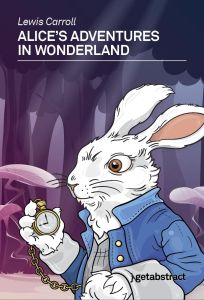
Alice’s Adventures in Wonderland
- Fantasy
- Victorian literature
What It’s About
Lewis Carroll’s tale Alice’s Adventures in Wonderland is a carnival mirror reflection of Victorian society with its rigid social conventions. While today’s social norms are undoubtedly different from those of Carroll’s time, the story’s underlying challenge still resonates: a child must navigate an unfamiliar world full of arbitrary and ridiculous adult rules, where fear is often the driving force for many participants’ decisions. The answers to riddles are questionable or non-existent. Rote learning offers no guides, tales lack morals. Alice’s good sense and her feeling for justice are indispensable to her success. Through her fantastical adventures, Alice challenges the idea that children should adapt to the adult world with its questionable principles and morality. She finds herself in an imperfect world that can be terrifying, yet her naive but sound judgment helps her survive and unveil the egotism, angst and violence surrounding her. Carroll’s satire of the era, hidden behind fabled creatures absorbed in absurd activities, was so poignant that Queen Victoria herself became Alice’s most eminent fan.
Summary
About the Author
Lewis Carroll was the pen name of Charles Lutwidge Dodgson, born the son of an English country parson on January 27, 1832. He studied mathematics at Christ Church College, Oxford and later worked at the college as a tutor, earning the rather dubious reputation of being a boring teacher. He was known as timid, yet he was rather popular in intellectual circles due to his versatile interests and broad knowledge. He drove his publishers and illustrators to distraction by always requesting last minute changes to manuscripts. He never passed up a public opportunity to criticize other people’s bad manners. As required by his position as a paid tutor at Christ Church, Dodgson was ordained to the Anglican priesthood as a young man, thus accepting the obligation to remain unmarried. Although he was very religious, he was never active as a clergyman, perhaps because he felt handicapped by his stammer. Dodgson was at ease in the company of children, particularly young girls. He wrote lengthy, earnest letters to them and told them stories, often adding logical paradoxes and riddles. In 1879, he published a treatise on Euclid’s significance to modern mathematics, and followed up with publications about logic in 1887 and 1894. Dodgson recognized the new medium of photography as one of the most interesting scientific phenomena of his time, becoming an important photographer. He took pictures of many of his famous contemporaries, as well as animals, objects and people, including a number of young girls – leading to 20th century speculation about his sexuality. Despite later controversy, his children’s portraits are now seen as superior works of art. Dodgson was not a prolific writer. Aside from Alice’s Adventures in Wonderland (1865) and Through the Looking-Glass, and What Alice Found There (1872), he wrote The Hunting of the Snark (1876), a nonsense poem unsurpassed in sheer absurdity, as well as Sylvie and Bruno (1889), and Sylvie and Bruno Concluded (1893). He died in Guildford, England, on January 14, 1898.









Comment on this summary